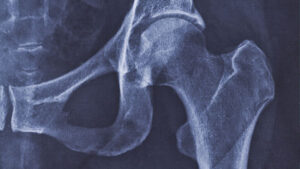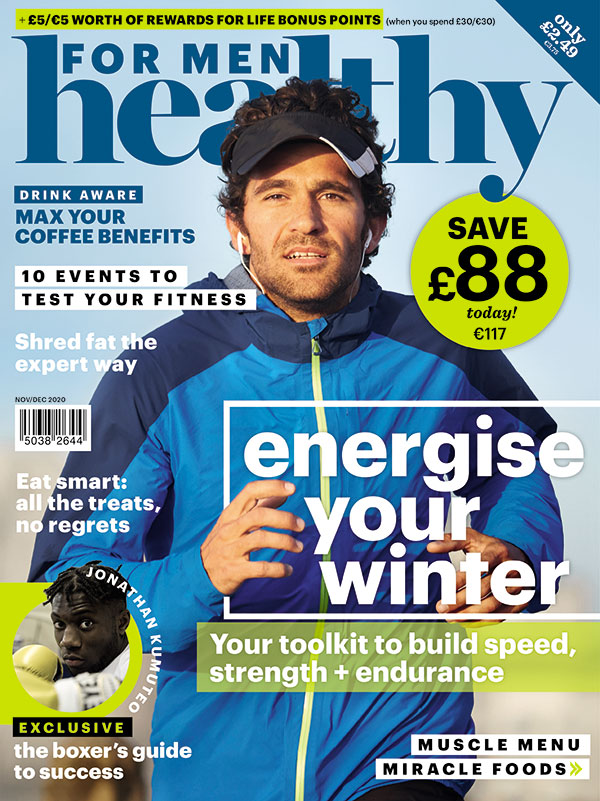
Knee, hip, wrist, elbow, feet and spine pain affects 22% of us in the UK. We spoke to the experts about how to keep your joints on point
Nearly 19 million people in Britain ‘have a musculoskeletal condition including arthritis’, according to the charity Versus Arthritis, the main campaigner for people with arthritis in the UK – and around 8.3 million of them are men. Arthritis can affect any age group – even children and teenagers – but it’s most often associated with midlife and older people. Although there’s no cure, Versus Arthritis say ‘treatments have improved greatly in recent years’, and for many types, particularly inflammatory arthritis, ‘there’s a clear benefit in starting treatment at an early stage.’
A recap: arthritis is all about your joints, especially those in your hips, knees, elbows, hands, wrists, feet and spine. This is where different bones meet, normally separated by cartilage and lubricating fluid. Arthritis is the word used to describe the pain, swelling and stiffness in these joints. The most common types are osteoarthritis, rheumatoid arthritis and gout. But there are other musculoskeletal problems that affect millions of us, too – back pain being a major culprit.
Osteoarthritis has been linked to obesity and trauma in the joints. It’s also hereditary, so if your parents or grandparents have it, you’re more likely to develop it, too. But it might not be inevitable, and there are ways
to help prevent it. A study from the American Academy of Orthopaedic Surgeons found weight loss may slow down the onset of osteoarthritis, and that obesity may trigger the inflammatory changes that cause osteoarthritis.
Keep moving
Contrary to what you may think, exercise can have a positive effect on joint pain. A study from Queen Mary University of London found that exercise can in fact help to prevent the damage to cartilage caused by osteoarthritis. This is because when we exercise, we compress the cartilage in our joints; our cells detect this, then work to stop inflammation. Other research has found that running reduces inflammation in knee joints, and a 2007 study found that most cardiovascular exercise helps keep knee cartilage healthy – though Versus Arthritis suggest low-impact is best to avoid added strain. If you’re looking to be extra safe, swap your weekly 10k run for a 5k, and add
in some low-impact exercise like Pilates. The Arthritis Foundation recommend yoga, as it builds strength and improves balance.
However, according to Philip Conaghan, professor of musculoskeletal medicine at the University of Leeds, and spokesperson for Versus Arthritis, joint pain is a wider problem than simply arthritis. ‘The commonest by far is back pain, and most of us experience an episode during our lifetime.’
In fact, back pain is the largest cause of disability in the UK. For many, it can feel like something they’re stuck with. But research suggests several solutions can help reduce and prevent pain. The NHS recommends staying active as a way to prevent back pain, and a review of medical literature in the Jama Network of journals found that exercise alone can help the symptoms of back injury.
‘When you’re younger, it’s more likely joint problems are due to tendinitis – inflammation where the ends of muscles attach to bones. As you get older, the chances of osteoarthritis increase, so you might have a combination
of arthritis and tendinitis.’
Killing the pain
Conaghan points to two types of treatments: first, the pharmacological ones such as painkillers, non-steroidal anti-inflammatory drugs (NSAIDs, such as ibuprofen), opioids, steroid injections and disease-modifying anti-rheumatic drugs (DMARDs). Secondly, there are non-pharmacological ones like weight loss, muscle strengthening and exercise.
‘Our society tends to like pharmacological treatments as they are quick,’ he says. ‘But non-pharmacological treatments, especially for mechanical joint problems, are probably the most effective therapy there is.’
Although Conaghan steers clear of recommending dietary supplements, others in the healthcare industry swear by them. Nutritionist Mays Al-Ali (healthymays.com) suggests that methylsulfonylmethane (MSM), chondroitin, glucosamine, turmeric and fish oil can all help to improve joint health. Meanwhile, plant-based health practitioner Dr Gemma Newman (plantpowerdoctor.com) says osteoarthritis sufferers may benefit from supplements such as sigesbeckia, boswellia serrata, pycnogenol and curcumin.
Of course, there is no silver bullet. Many patients benefit from a combination of diet, exercise and pain control. Alex Beechey
is a musculoskeletal physio for Connect Health, and an academy physio for Tottenham Hotspur Football Club. ‘Arthritis is best managed like a jigsaw puzzle,’ he says. ‘No one piece will significantly affect the overall picture, but the right combination of pieces will see the best management. Remember, the human body is complicated and differs from person to person. It may require lots of patience, and trial and error.’
Know your joint issues
Osteoarthritis
The big one, with around 8.75 million Britons seeking treatment, including a quarter of men aged 45 to 65. It occurs when the cartilage between the joints roughens. The most commonly affected areas are the knees, hands, hips and back.
Gout
A type of inflammatory arthritis caused by excess uric acid in the body which forms into crystals around the joint. Typically, it’s the big toes that are painful, with men more affected than women. Men can develop gout as early as their mid-20s.
Rheumatoid arthritis
An autoimmune condition in which the
body inflames the joints with excess fluid.
‘It most commonly starts among people aged 40 to 60, and is more common in women than men,’ say Versus Arthritis. Around 400,000 Britons suffer from it.
Spondyloarthritis
A inflammation of connective tissues around the joints of the spine. The most common type is ankylosing spondylitis. It’s more common among men in their 20s.
Juvenile idiopathic arthritis
An autoimmune disorder affecting the joints in children under 16. Around 12,000 young Britons have this condition.
For more information, visit versusarthritis.org
Photograph: iStock by Getty Images

Find more expert health advice in the latest issue of Healthy For Men, on sale now in Holland & Barrett stores and online at hollandandbarrett.com

